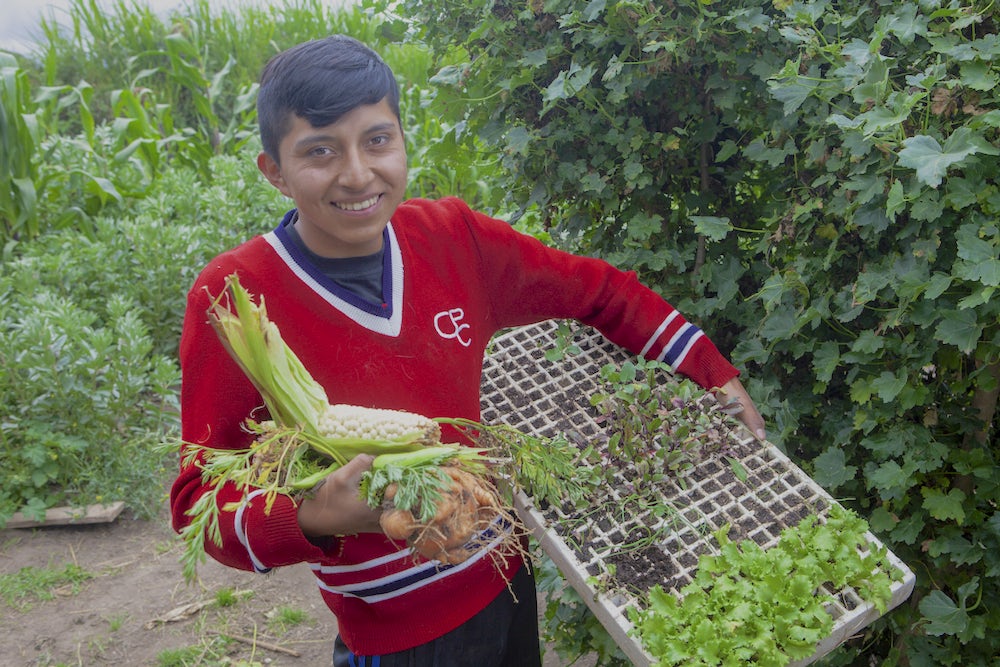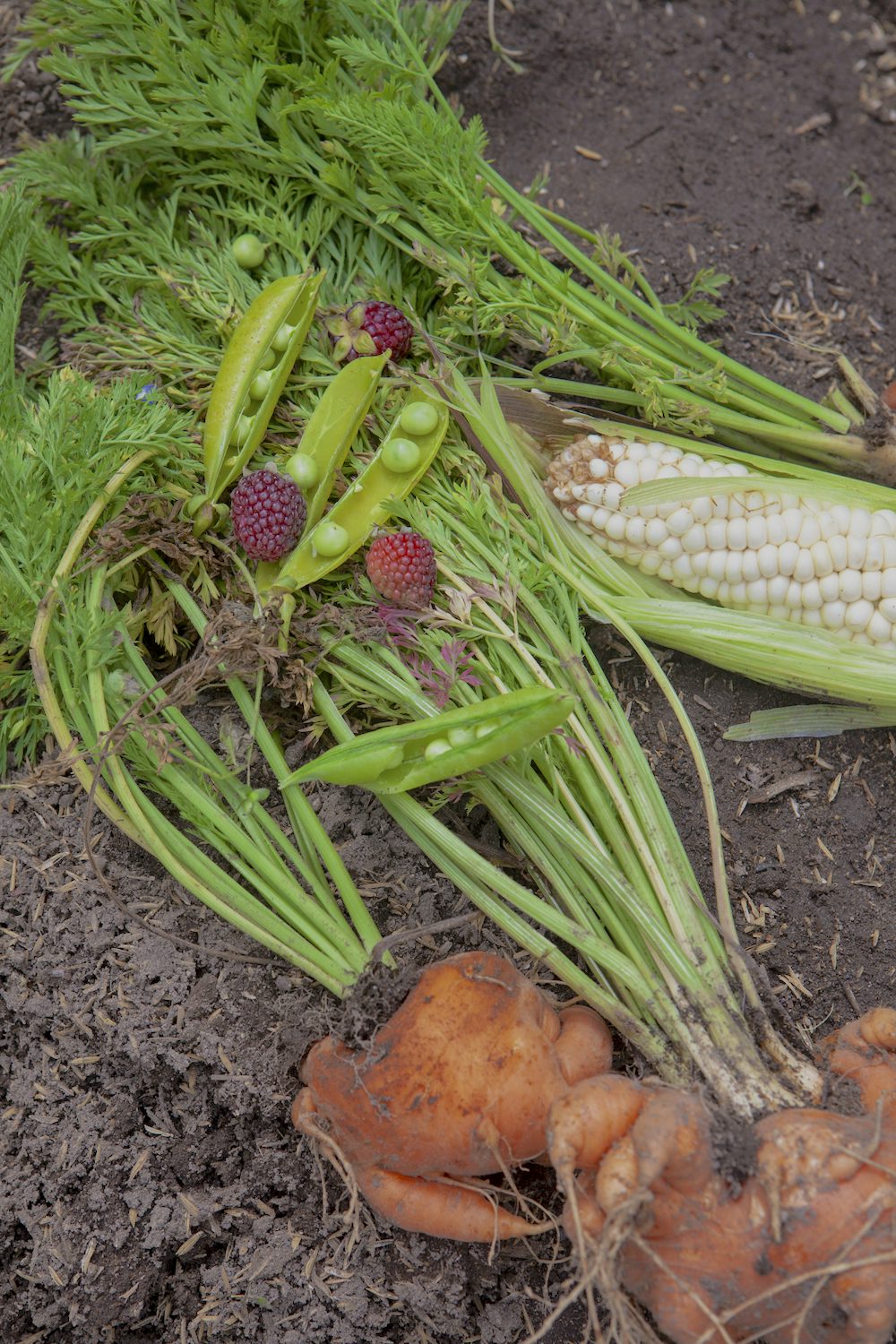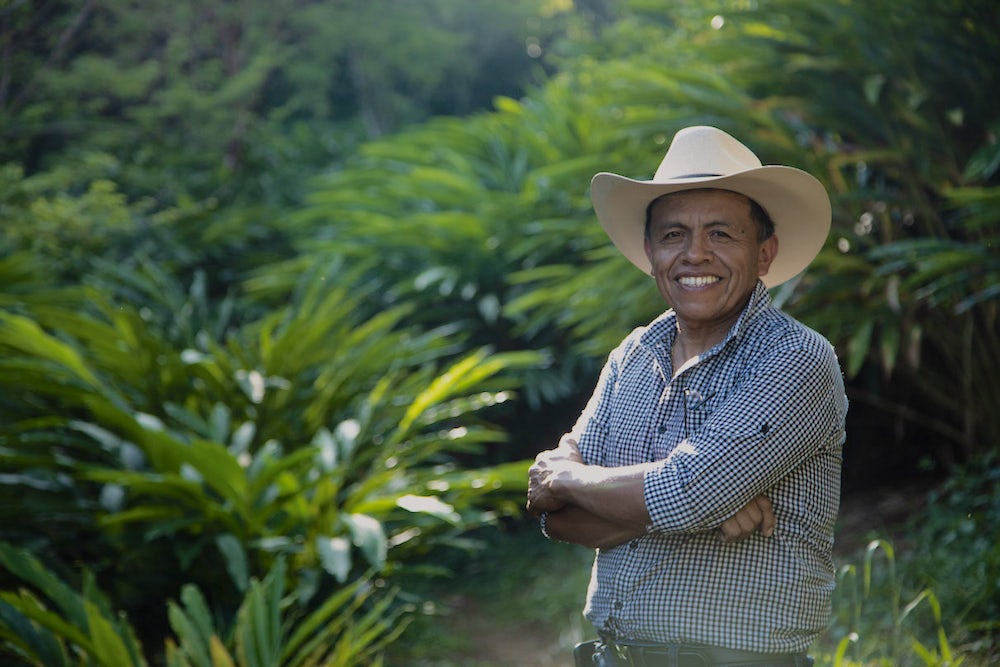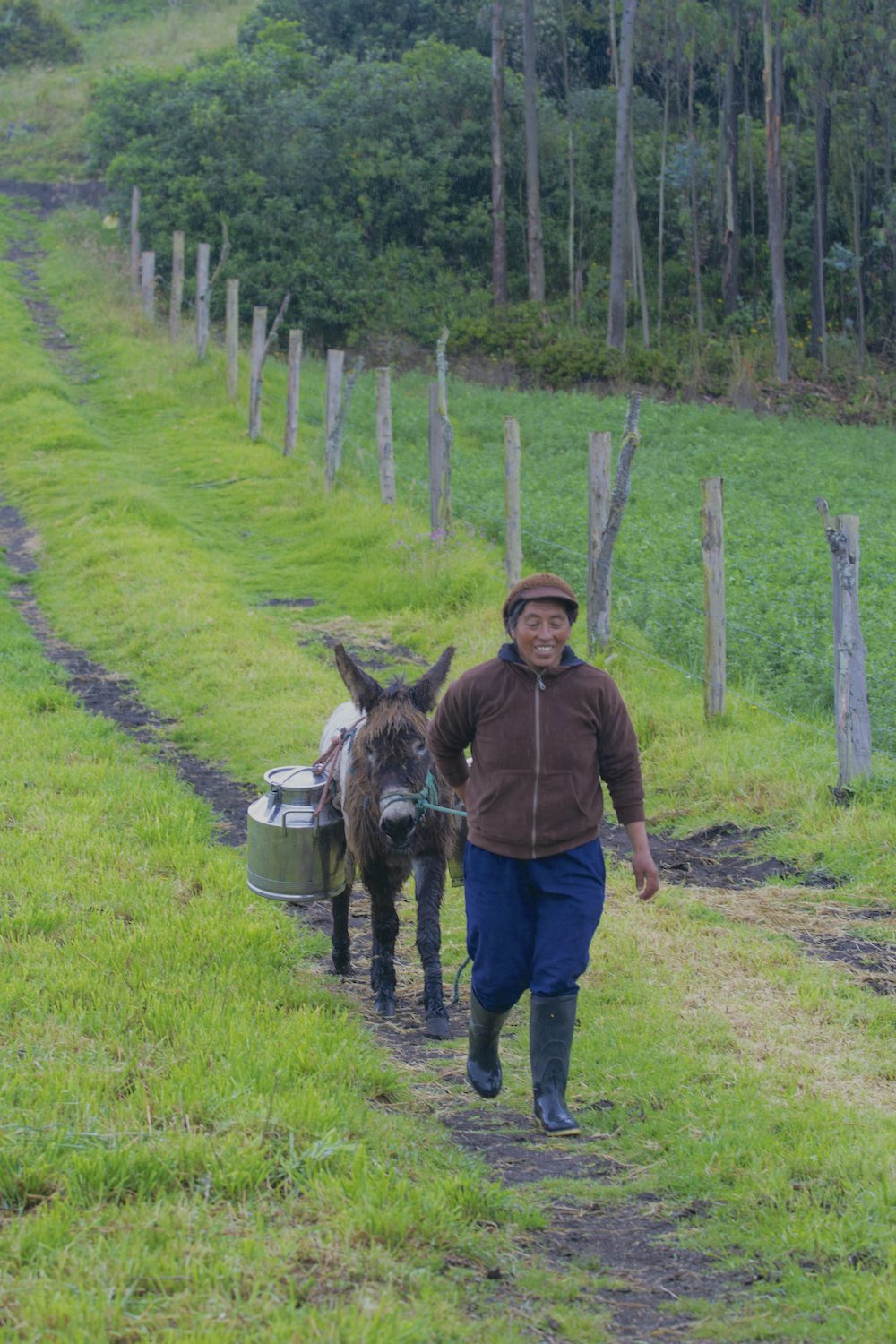Written by Lauren Puchowski
Along the road to the small community of San Isidro, tucked into the lowlands of the Andes in Ecuador, there is little to see, just a windblown expanse of dusty brown. What was once rich cropland is now more like sand, almost unplantable, stripped of nutrients and humus by decades of farming and harsh pesticides, and vulnerable to drought and erosion from the wind. Desperate to find arable land, farmers here have begun venturing up into the green hills nearby, into the fragile ecosystem called the paramo. The paramo is the region’s primary water source, and if it is destroyed, the already troubled area will fare far worse.

Behind a low yellow house in the village, however, is a vision of a different future. Slip through a dense line of trees and into another world: a lush tangle of foliage, fruit, and blooms, bursting from their orderly rows like a vision of a farm in a fairytale. There is a whole farmers market worth of produce growing on this tiny plot, including blackberries, broccoli, cabbages, red onions, strawberries, shell corn, squash, tomatoes, fava beans, a local berry called goldenberry, tangy and juicy in its papery husk, and two kinds of local hanging fruits. There are animals, too: rabbits, guinea pigs, chickens and a pen with several piglets. Birds chirp merrily in the bushes, and the air, suddenly still, is sweet with the smell of rich soil and new growth. It even feels warmer, somehow.
“It is about two or three degrees warmer,” confirms Jofre Guaman, the young farmer who created this idyll over the last year and a half entirely of his own initiative, after receiving training in organic and sustainable farming techniques from Heifer. “That is because of the trees, which serve as a natural windbreak, and the plants.” Don’t be fooled, in other words, by the sheer poetry of the place — this is science. Each element of the garden serves a purpose, and the riotous bounty is underpinned by a thousand deliberate decisions, most of them cheap or free, that increase production, eliminate pests without chemicals and restore the soil.
The crops, for example, are planted in mutually beneficial pairs, like fava beans and shell corn, or peas and blackberry bushes. Companion crops, as these are known, grow better together than apart, protecting each other from pests and preventing depletion of the soil. Instead of using chemical fertilizers, Guaman, 20, makes his own organic formula by composting animal manure with ash and rice husks. The tree barrier prevents erosion and stops chemicals drifting in from other farms, and clippings from the trees are used to enrich the soil. A simple irrigation system keeps conditions ideal for growth.
The result, after 18 months, is a sort of naturally reverse-engineered Eden, as fertile, bio-diverse and productive as the most unspoiled swatch of heartland. The best indicator of this is the soil. “It keeps getting better and better,” says Guaman. “Watch.”
Crouching down, he reaches through the protective row of trees and grabs a handful of the soil outside the garden; with his other hand, he scoops up a fistful at his feet. Like a magician on a stage, he opens his hands: the soil from outside runs through his fingers like dust, while the soil from his garden has packed into a damp, dark ball.
Guaman grins. “This one is infertile,” he says, motioning at the sandy soil. “This one,” he says, holding up the other, “is alive.”

Worldwide, the overwhelming majority of farms look a lot like Guaman’s: small — under five acres — and family-run, often by the very poor. Small family farms produce as much as 80% of the world’s food supply, especially in developing countries. And yet for most of the 20th century, bigger was considered better in agriculture. Large farms were thought to make the most economic sense. Producing more meant using more — more land, more water, more chemicals. Technological advances focused on industrial farming. Small farms were considered virtually useless in the global economy, simply a way for poor people to grow enough food to survive.
But over time the thinking changed. We are far more aware now that land and water are finite resources, that industrial farming is not always sustainable and sometimes damaging, and that small farms, with the right approaches, can be just as efficient as large ones. A wave of new technology and innovations designed specifically for small farmers means that they can produce more than ever.
We also know that small-scale farming can transform the lives of the poor. Where small-scale farming was once considered, as William Maloney notes in the World Bank’s report Harvesting Prosperity (2020), to be “a deep pool of cheap labor” from which workers should escape as quickly as possible to more profitable economic sectors, like service or manufacturing, it is now understood as a key to the economic success of developing countries. Growth in agriculture reduces poverty more than growth in any other sector, precisely because so many of the poor are farmers. When innovation and technology increase the productivity of small farms, writes Maloney, farming becomes “a powerful driver of growth that raises people out of poverty and contributes to overall development.”
So how can technology and innovation increase productivity? It’s tempting to imagine a single gizmo, cleverly designed, inexpensively made, that transforms small farms around the globe. But the reality is more complicated, because there are numberless ways for smallholder farms to be inefficient.
A farmer might have plenty of land but no labor, or plentiful labor but only a little land. She might have rich soil on a remote hilltop far from the road, or she might have poor soil on a plot in town. (One study in Ethiopia found that the cost of transporting a sack of fertilizer from a distribution center to a farm, a distance of 10 kilometers, was equal to the cost of transporting it 1,000 kilometers, from the port to the distribution center.) She might have an infestation of pests, no irrigation or planting methods that she thinks are good but are actually bad, like putting too many seeds in one hole. Middlemen might control the market for her harvest and take her profits.
Instead, the future of innovation in agriculture looks more like Guaman’s plot of land: crowded with a thousand different ideas, all of them intentional, resourceful and, most of all, smart. The biggest task becomes finding the solutions that will work for the problems, and the people, that you have.
Take, for example, the cardamom crop in Guatemala, the world’s biggest. Some 300,000 small-scale farmers in Guatemala grow almost two-thirds of the global supply. Known as “the grass that gives money,” it requires almost no attention and sells for as much as $4 per pound. But there are two big drawbacks to cardamom farming as it is traditionally practiced here. One is that cardamom is often a farmer’s only crop; it is vulnerable to pests that can lower its value by as much as 70%, and a bad harvest can be devastating. The other drawback is the way it is processed, almost always in inefficient, polluting wood-fired dryers run by middlemen, who clear-cut 5,000 acres of wood for the twice-yearly harvest.

Heifer Guatemala saw the gross inefficiencies in the system, as well as the poverty and environmental damage it caused, and knew that farmers as well as the country would benefit from improvements. But Heifer is not a research institution, as Heifer Guatemala National Project Coordinator Larry Paul observes, and despite being largely agrarian, Guatemala does not have a robust agricultural research sector. “Research institutions here lack funds,” Paul says. The United States provides some funding, “but their investment is mostly to fight poverty in the Western highlands,” the region of Guatemala that borders Mexico and has the heaviest immigration north.
It took a collaboration with several local and international organizations, as well as Texas A&M University, for the process to begin. Heifer Guatemala and other Guatemalan organizations identified the priorities: cleaner and more sustainable drying processes, pest prevention, better yields, improved marketability. Texas A&M studied the compounds in cardamom that could reduce diabetes (and perhaps create a new market). The group Engineers Without Borders designed a new industrial dryer that could be solar powered, gas or electric, and that dried the cardamom on trays rather than in bulk, improving its quality. An inexpensive organic fertilizer and safe, effective pesticides were identified.
Heifer began working with hand-picked groups of what Paul calls “the best farmers, with the best land,” who could serve as examples to the rest. There were successes: The organic fertilizer as much as doubled production with minimal investment, costing only $20 per 1,000 square meters. And there were misses: The new, more efficient cardamom dryer cost $16,000, about $4,000 more than a traditional woodfired dryer, far out of reach for farmers and most middlemen, and the team calculated that implementation across the country would take 20 to 50 years.
Students at the Milwaukee School of Engineering, which has ties to Engineers Without Borders, volunteered to continue work on the dryer problem, ultimately designing an adaptation that improved efficiency less dramatically but was much more affordable and could be rolled out more quickly. Based on the early good results with the organic fertilizer, Heifer expanded its initial group to 6,000 farmers, with a target goal of 30,000. At the same time, they began to teach farmers about diversifying their farms with other spices like black pepper and allspice, to hedge against disaster if the cardamom failed.
Like those fertilizers, some of the best technology is not high-tech at all. In Honduras, farmer Antonio Espinoza, 58, has been working with Heifer and government agencies to breed hardier beans for the national food bank. Among the methods that Heifer taught him is the simple strategy of burning a candle in a sealed silo of beans to remove the oxygen, which allows longer storage. And, as in many developing countries, the old-fashioned tool of radio is an effective way to reach farmers here; Espinoza has recently begun hosting a regional talk show, “El Zarzo” (“The Pantry”), in which he shares improved cultivation and production techniques that he has learned from Heifer.
But of course, the advent of digital technology, where available, has allowed dramatic strides. Even in developing countries many farmers have cell phones, which makes communication much easier. Heifer’s goat farmers in rural Nepal use text messaging to arrange sales and collection of their animals, saving a great deal of time and effort. Digital tech also facilitates an approach called “precision farming,” in which farmers monitor data from their crops and livestock to make the best decisions about the use of their resources. The goat farmers have begun using an app called the Feeding Support Tool to calculate how much to feed their animals to keep them healthy while reducing production costs.
Digital tech also shows promise for improving the supply chain. Blockchain technology, a digital approach to record-keeping that makes the details of each transaction transparent to all parties, is being explored in Honduras Heifer projects to help eliminate gouging by middlemen and ensure fair prices for farmers.
There are also actual gizmos, like the Barsha pump used in Nepal, a simple wheel placed in a stream that harnesses the flow of water in a river to irrigate crops. And sometimes the best answer is a combination of several. Heifer Ecuador helped local farmers open a scaled-down version of an industrial dairy processing plant in a remote region in the highlands to help them control the sales of their product. A truck was deployed to collect milk from farmers but some lived on impassable roads. Miguelina Barrero, whose steep, narrow slice of farmland was one of the unreachable ones, availed herself of the best technology for that problem: a sturdy little burro, who nimbly scales the hill with her to meet the truck each morning, loaded with two brimming milk cans.

Ultimately, innovation and technology are perhaps best thought of as an approach, rather than a product. In agriculture, it is an approach that routinely delivers results. The regions that spend the least on agricultural research and development, like Africa and South Asia, have had the lowest agricultural growth in recent decades. Maloney says that the social returns, or the added value that is not directly financial, on research and development in agriculture average more than 40%. And yet private investors often aren’t interested in funding this kind of research because the profits are less likely to benefit them directly. The burden of funding rests with the government, which often, as in Guatemala, does not provide it.
The result, in these countries, is a poverty of vision as well as of means. Jofre Guaman says that the techniques he used to create his farm are not widely taught in Ecuador, despite their effectiveness. “What I hear from the engineers who are my teachers is that this is impossible to learn about here in Ecuador,” he says. “Only Heifer teaches it.” He intends to use his farm as a demonstration tool, to teach agroecology and organic farming to this community, as he sees how great the need is. “Many people do not appreciate what I am doing here,” he says.
Viewed in this light, the struggles of small farms look less like a result of poverty than a symptom of neglect, an indication that countries aren’t investing in a potentially vast engine of growth — or in the people who could power it. Espinoza, 58, has long been a leader in his community (see sidebar), but he had few opportunities to learn after leaving school in the 4th grade to help his father in the fields. The biggest benefit of working with Heifer, he says, has been the knowledge that he can share with others. “I feel like I planted a tree and it is producing,” he says. “And it fills me with pride.”

Guaman, who did not have the grades to attend college, says that what he learned about farming from Heifer changed the course of his life. “To me, as a youth, it gave me knowledge that no university could give me,” he says. “I want to teach my people these ways.”
The work of a solitary farmer who, given the methods, grew a farm on barren land, is perhaps the best argument for innovation’s potential to strengthen both an industry and its people. “There was nothing here before,” says Guaman, waving a hand at his plants. “And now I am transforming it.”
